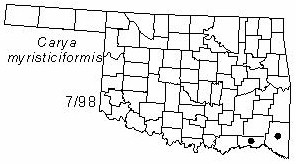Tree to 20 m (65 ft) tall and 50 cm (18 in) diameter, with rounded crown of bronze-tinged foliage. Bark dark brown, becoming fissured into long thin scales on older trunks and branches. Twigs slender, brown, with very small brown or yellow scales. The single terminal bud is brown, narrow, with nonoverlapping paired scales. Leaves alternate, pinnately compound, 19-36 cm (7.5-14 in) long, with a slender scurfy-hairy rachis. Leaflets 5-9, broadly lanceolate, 5-13 cm (2-5 in) long, acuminate, finely serrate, hairy dark green above, shiny whitish to yellow-bronze below. Flowers catkins appearing in the early spring. Fruits elliptical, 2.5-3 cm (1-1.2 in) long, with a thin husk splitting along four ridges.
Distribution: Native to the coastal plain of southeastern U. S.
Habitat: wet floodplain forests.
NWI status: FACW-
Comment: The nuts of all the hickories are important food for wildlife, especially squirrels. The seeds of nutmeg hickory are smooth and thick-shelled but edible. Carya is the ancient Greek name for walnut; myristiciformis means "shaped like myristicae (nutmegs)", and refers to the nut.
Distribution in Oklahoma: 
BACK
NEXT
RETURN TO INDEX
Last update: 9/8/99
 Go to Oklahoma Biological Survey Home Page
Go to Oklahoma Biological Survey Home Page
 Disclaimer
Disclaimer